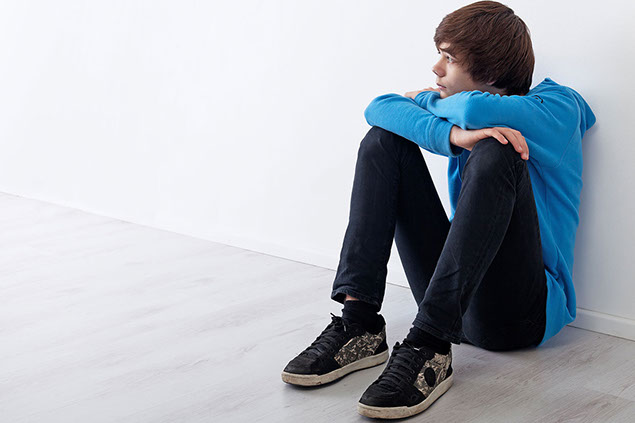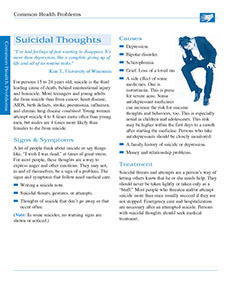CONDITIONS
SYMPTOM CHECKER
Male
Female
Child
Arm, Hand & Shoulder Concerns
Legs & Feet Concerns
Dental & Mouth Concerns
Ear & Nose
Eye Conditions
Head Conditions
Arm, Hand & Shoulder Concerns
Legs & Feet Concerns
Front
Back
Arm, Hand & Shoulder Concerns
Dental & Mouth Concerns
Ear & Nose
Eye Conditions
Head Conditions
Arm, Hand & Shoulder Concerns
Dental & Mouth Concerns
Ear & Nose
Eye Conditions
Head Conditions
Front
Back
Arm, Hand & Shoulder Concerns
Neck Links
Head & Neck Concerns
Arm, Hand & Shoulder Concerns
Neck Links
Head & Neck Concerns
Front
Back
Online Clinic
Wise Healthcare
Suicidal Thoughts
Print on Demand
RELATED ARTICLES
For persons 15 to 24 years old, suicide is the third leading cause of death, behind unintentional injury and homicide. More teenagers and young adults die from suicide than from cancer, heart disease, AIDS, birth defects, stroke, pneumonia, influenza, and chronic lung disease combined. Young women attempt suicide 4 to 8 times more often than young men, but males are 4 times more likely than females to die from suicide.
Signs & Symptoms
A lot of people think about suicide or say things like, “I wish I was dead,” at times of great stress. For most people, these thoughts are a way to express anger and other emotions. They may not, in and of themselves, be a sign of a problem. The signs and symptoms that follow need medical care.
• Writing a suicide note.
• Suicidal threats, gestures, or attempts.
• Thoughts of suicide that don’t go away or that occur often.
Causes
• Depression.
• Bipolar disorder.
• Schizophrenia.
• Grief. Loss of a loved one.
• A side effect of some medicines. One is isotretinoin. This is prescribed for severe acne. Some antidepressant medicines can increase the risk for suicidal thoughts and behaviors, too. This is especially noted in children and adolescents. This risk may be higher within the first days to a month after starting the medicine. Persons who take antidepressants should be closely monitored.
• A family history of suicide or depression.
• Money and relationship problems.
Treatment
Suicidal threats and attempts are a person’s way of letting others know that he or she needs help. They should never be taken lightly or taken only as a “bluff.” Most people who threaten and/or attempt suicide more than once usually succeed if they are not stopped. Emergency care and hospitalization are necessary after an attempted suicide. Persons with suicidal thoughts should seek medical treatment.
Resources
Your school’s Student Counseling or Mental Health Service or Student Health Service
American Foundation for Suicide Prevention
888.333.AFSP (2377)
(This is not a crisis hotline.)
Metanoia Communications
National Suicide Prevention Lifeline
800.273.TALK (273.8255)
Questions to Ask
Question 1
At this time, are any of the following present?
• Suicide attempts or gestures, such as standing on the edge of a bridge, cutting the wrists, or driving recklessly on purpose.
• Plans are being made for suicide. Has the person purchased or gotten a weapon or pills that could be used for suicide?
• Repeated thoughts of suicide or death.
Get medical care without delay. If symptoms are life threatening go to the ER or call 9-1-1. Don’t call 9-1-1 or use the ER if symptoms do not threaten life. Ask your doctor ahead of time where you should go for a problem that needs prompt care, but not emergency care.
Question 2
Has the person recently done any of the following?
• Given repeated statements that indicate suicidal thoughts, such as “I don’t want to live anymore,” or “The world would be better off without me.”
• Given away things he or she values most and gotten legal matters in order.
• Suddenly felt better after being very depressed and stated something like, “Now I know what I have to do.”
You should be seen by your doctor for medical advice. Contact your doctor or health care provider to find out how soon you should be seen.
Question 3
With thoughts of suicide or death, are any of these conditions present?
• Depression or bipolar disorder.
• Schizophrenia.
• Any other mental health or medical condition.
You should be seen by your doctor for medical advice. Contact your doctor or health care provider to find out how soon you should be seen.
Question 4
Have thoughts of suicide occurred after taking, stopping, or changing the dose of a prescribed medicine (this includes certain antidepressants) or using drugs and/or alcohol?
You should be seen by your doctor for medical advice. Contact your doctor or health care provider to find out how soon you should be seen.
Question 5
Does the person thinking about suicide have signs and symptoms of depression?
You should be seen by your doctor for medical advice. Contact your doctor or health care provider to find out how soon you should be seen.
Question 6
Does the person thinking about suicide have other blood relatives who attempted or died from suicide?
You should be seen by your doctor for medical advice. Contact your doctor or health care provider to find out how soon you should be seen.
Question 7
Have suicidal thoughts come as a result of any of the following (or any other) upsets in life?
• A relationship breakup.
• The death of a loved one.
• A rejection or being ridiculed.
You should be seen by your doctor for medical advice. Contact your doctor or health care provider to find out how soon you should be seen.
Use Self-Care / Prevention:
You can probably take care of the problem yourself if you answered NO to all the questions. Use the “Self-Care” measures that are listed. Call your doctor if you don’t feel better soon, though. You may have some other problem.
Self-Care / Prevention
If You Are Having Thoughts of Suicide
• Let someone know. Talk to a trusted family member, friend, or teacher. If it is hard for you to talk directly to someone, write your thoughts down and let someone else read them.
• Call your school’s Mental Health Service, your local Crisis Intervention Center or the National Suicide Prevention Lifeline at 800.273.8255. Follow up with a visit to your health care provider or your school’s Mental Health Service.
How to Help a Friend Who May Be Suicidal
• Take him or her seriously. If your friend informs you of suicidal intentions, believe the threats.
• Keep firearms, drugs, etc. away from persons at risk.
• Take courses that teach problem solving, coping skills, and suicide awareness.
• If you think the person is serious about suicide, get help. Watch and protect him or her until you get help. Keep the person talking. Ask questions, such as, “Are you thinking about hurting or killing yourself?”
• Urge the person to call for help. If he or she is already under the care of a health care provider, have the person contact that provider first. If not, other places to contact are listed in the box below. Make the call yourself if the person can’t or won’t.
• Express concern. The person needs to know that someone cares. Most suicidal persons feel alone. Tell the person how much he or she means to you and others. Talk about reasons to stay alive. Don’t judge. The person needs someone to listen, not to preach moral values.
• Tell the person that depression and suicidal tendencies can be treated. Urge him or her to get professional care. Offer help in seeking care.
This website is not meant to substitute for expert medical advice or treatment. Follow your doctor’s or health care provider’s advice if it differs from what is given in this guide.
The American Institute for Preventive Medicine (AIPM) is not responsible for the availability or content of external sites, nor does AIPM endorse them. Also, it is the responsibility of the user to examine the copyright and licensing restrictions of external pages and to secure all necessary permission.
The content on this website is proprietary. You may not modify, copy, reproduce, republish, upload, post, transmit, or distribute, in any manner, the material on the website without the written permission of AIPM.
2021 © American Institute for Preventive Medicine - All Rights Reserved. Disclaimer | www.HealthyLife.com
















































